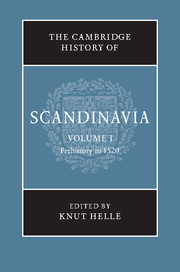Book contents
- Frontmatter
- Introduction
- PART I THE GEOGRAPHY AND PREHISTORY OF SCANDINAVIA
- 1 The Scandinavian Landscape and its Resources
- 2 The Stone and Bronze Ages
- 3 The Iron Age
- 4 Languages and ethnic groups
- PART II FROM VIKINGS TO KINGS
- PART III MATERIAL GROWTH (to c. 1350)
- PART IV THE HIGH MEDIEVAL KINGDOMS
- PART V HIGH AND LATE MEDIEVAL CULTURE
- PART VI LATE MEDIEVAL SOCIETY (c. 1350–1520)
- PART VII SCANDINAVIAN UNIONS (1319–1520)
- Conclusion
- Select bibliography: primary sources, general surveys and secondary works arranged by part
- Index
- Plate Section"
- References
3 - The Iron Age
from PART I - THE GEOGRAPHY AND PREHISTORY OF SCANDINAVIA
Published online by Cambridge University Press: 28 March 2008
- Frontmatter
- Introduction
- PART I THE GEOGRAPHY AND PREHISTORY OF SCANDINAVIA
- 1 The Scandinavian Landscape and its Resources
- 2 The Stone and Bronze Ages
- 3 The Iron Age
- 4 Languages and ethnic groups
- PART II FROM VIKINGS TO KINGS
- PART III MATERIAL GROWTH (to c. 1350)
- PART IV THE HIGH MEDIEVAL KINGDOMS
- PART V HIGH AND LATE MEDIEVAL CULTURE
- PART VI LATE MEDIEVAL SOCIETY (c. 1350–1520)
- PART VII SCANDINAVIAN UNIONS (1319–1520)
- Conclusion
- Select bibliography: primary sources, general surveys and secondary works arranged by part
- Index
- Plate Section"
- References
Summary
General perspectives
The geographical location of Scandinavia is an important reason why the region has always had cultural contacts in two directions – across Finland and the Baltic to the eastern part of the European continent and across Denmark and the North Sea to central and western parts of Europe. Climatic and geological factors go a long way towards explaining why arable farming gradually came to be the principal economy in southern Scandinavia and in coastal districts of Norway, Sweden and southern Finland, whereas hunting, fishing and pastoral farming were more important in the northern regions and the interior.
In the Bronze and Iron Ages Scandinavia therefore became a meeting place for two contrasting cultural traditions, the north-east European hunting societies in the north and the continental agrarian societies in the south (see Chapter 2). The boundary between these was not permanently fixed, but generally it can be drawn from Viborg in the east through Vaasa and Umeå to southern Troms in the west. The agrarian societies showed a general tendency to expand northwards during the Iron Age, particularly along the coasts of northern Norway, northern Sweden and Finland. On the other hand, the people inhabiting the interior uplands and forests of Norway and Sweden as far south as Trøndelag and Jämtland were strongly influenced by those in the northern area.
Keywords
- Type
- Chapter
- Information
- The Cambridge History of Scandinavia , pp. 60 - 93Publisher: Cambridge University PressPrint publication year: 2003
References
- 9
- Cited by

